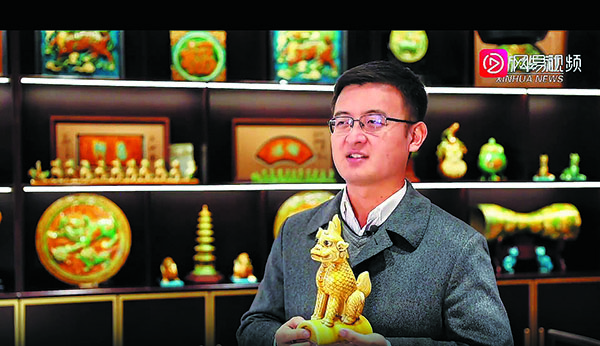Colored glaze helps to shine light in France on Chinese fortress
XINHUA | Updated: 2023-12-11 08:47

PARIS/TAIYUAN — In Houetteville Castle in Normandy, France, colored glaze products from China have been on display for more than half a month, and many people have come here to see these exquisite artworks from the East.
The company overseeing the Shanxi Zhangbi Ancient Fortress was invited to participate in the Salon International du Patrimoine Culturel at the Louvre Museum in Paris from Nov 2-5. In just a few days, this ancient fortress with a history of more than 1,600 years attracted thousands of people, and its colored glaze cultural products were popular at the expo.
"To let more people know about these exquisite artworks, I advised Lu Yang, the head of Zhangbi Ancient Fortress scenic spot, to display them at our castle in Normandy after the expo, and then tour Europe," says Nathalie Geslin-Yu, president of the Club Des Chatelains Chinois de France (Chinese owners of French chateaux club), a French castle organization. "The brilliant colors and oriental shapes of the cultural products attract people. I bought a collection myself."
The colored glaze pieces are handmade and include ceramics, models of buildings and sculptures. Colored glaze items were widely used to decorate palaces, temples and pagodas in ancient China because of their color and different shapes.
"The artwork has elegant lines and gorgeous colors, which is highly appreciated and collectible," says Bai Huaibin, an expert in traditional colored glaze production who participated in the expo.
Lu says the most popular exhibit at the expo is a representation of Xie Zhi, a one-horned mythical creature reputed to be able to distinguish between good and evil. This doeeyed creature has long been popular in China, even before it made its appearance in France.
"Xie Zhi was often placed on the roofs in ancient times and is a symbol of bravery and justice. Now they often appear at the gates of courts and procuratorates," says Lu, who mentioned that Xie Zhi resembles the unicorn in Western culture, a creature that symbolizes purity and is believed to suppress anything morally degraded.
In Jiexiu city, North China's Shanxi province, where Zhangbi Ancient Fortress is located, there are many colored glaze items that are hundreds of years old, among which the components on the top of the Kong Wang Hall in the fortress are particularly exquisite.
Rebuilt in 1631, the roof of the hall is decorated with differently shaped yellow, green, and blue glaze components, such as dragons, phoenixes, peonies and warriors. In addition, the two peacock blue tablets located under the eaves of Kong Wang Hall are the only Ming Dynasty (1368-1644) colored glaze tablets to have been found in China so far.
The reason why these components were well-preserved is closely related to the fortress' military purpose. Lu says that in ancient times, Zhangbi Ancient Fortress was located in the border zone between the northern nomads and the central plains. To resist foreign enemies, the ancients built a military and civilian castle with tall walls and underground tunnels, which could be used in wartime to ready troops, and to store grain during peacetime.
Gong Hua, secretary-general of the World Castle Association, says that when it comes to castles or fortresses, many would think of Europe, but China actually also has many castles, especially in Shanxi province, and the numerous castles in the Fenhe River and Qinhe River basin are comparable to the world-famous French Loire Valley castle group.
"This exhibition gives the European public access to Chinese castles for the first time through videos and cultural and creative artworks. The original introduction video, without any explanation, was watched by many visitors from beginning to end. Many people have expressed interest in going to China to see more castles," Gong says.
Lu says that during the expo, French castle owners, European cultural heritage industry associations, companies and castle lovers had extensive exchanges with him on the protection of historical buildings, cultural tourism industry development and other topics.
"France has many cultural protection and development enterprises. … I hope we can continue to expand cooperation areas in the future," says Lu.
"Castles are an important part of world cultural heritage and a common topic between Chinese and foreign cultures," says Gong, adding that they will take the opportunity of the 60th anniversary of the establishment of diplomatic ties between China and France and the Year of Culture and Tourism between China and France next year to promote cultural connectivity between the two countries through cultural exchanges and cooperation.
























